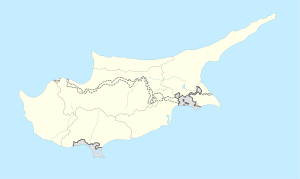Ayia Napa
| Ayia Napa | ||
|---|---|---|
| Αγία Νάπα (Greek) Aya Napa (Turkish) |
||
 |
||
|
||
| Location of Ayia Napa within Cyprus | ||
| Coordinates: 34°59′N 34°00′E / 34.98°N 34.00°ECoordinates: 34°59′N 34°00′E / 34.98°N 34.00°E | ||
| Country |
|
|
| District | Famagusta District | |
| Government | ||
| • Mayor | Yiannis Karousos | |
| Population (2001) | ||
| • Total | 2,693 | |
| Time zone | EET (UTC+2) | |
| • Summer (DST) | EEST (UTC+3) | |
| Website | http://www.ayianapa.org.cy/ | |
Ayia Napa (officially romanised Agia Napa; Greek: Αγία Νάπα [locally [aˈʝanːapa]]; Turkish: Aya Napa) is a resort at the far eastern end of the southern coast of Cyprus.
The name Ayia Napa is derived from a Venetian-era monastery of the same name, located in the centre of the town, next to the square that today is the clubbing centre. The word "Ayia" (Agia) means "holy" in Greek. "Napa" is archaic and means "wooded valley" or dell. In ancient times the area surrounding the town was covered with thick forest.
According to local legend, the now renowned original icon was accidentally discovered by a hunter in pursuit of his prey. Upon discovery, the icon of the Virgin Mary was called Virgin Mary of Napa, eventually shortened and now known as Ayia Napa. The present monastery, built in 1100, was built around the cave, in honour of the Virgin Mary of Ayia Napa. According to local tradition, until 1790 no one lived within close vicinity of Ayia Napa. The first inhabitants were from Thessaloniki, Greece. The name of the first inhabitant of Ayia Napa was Nikolaos Kemitzis from Thesaloniki. He arrived from Greece around 1790 and got married to a village located on the northern east part of Ayia Napa and Paralimni, the name of the village was Panayia. Soon after the marriage Kemitzis had a fight with the Ottoman authorities which ruled Cyprus at the time, and decided to move near the monastery of Ayia Napa.
Geographically, Ayia Napa lies near Cape Greco at the eastern part of Cyprus, just south of Famagusta and forms part of a larger area known as Kokkinochoria ("Red Villages", a name derived from the red colour of their soil). It is a town of Famagusta District, in the remaining southern part of the district occupied by Turkish forces in 1974.
...
Wikipedia


